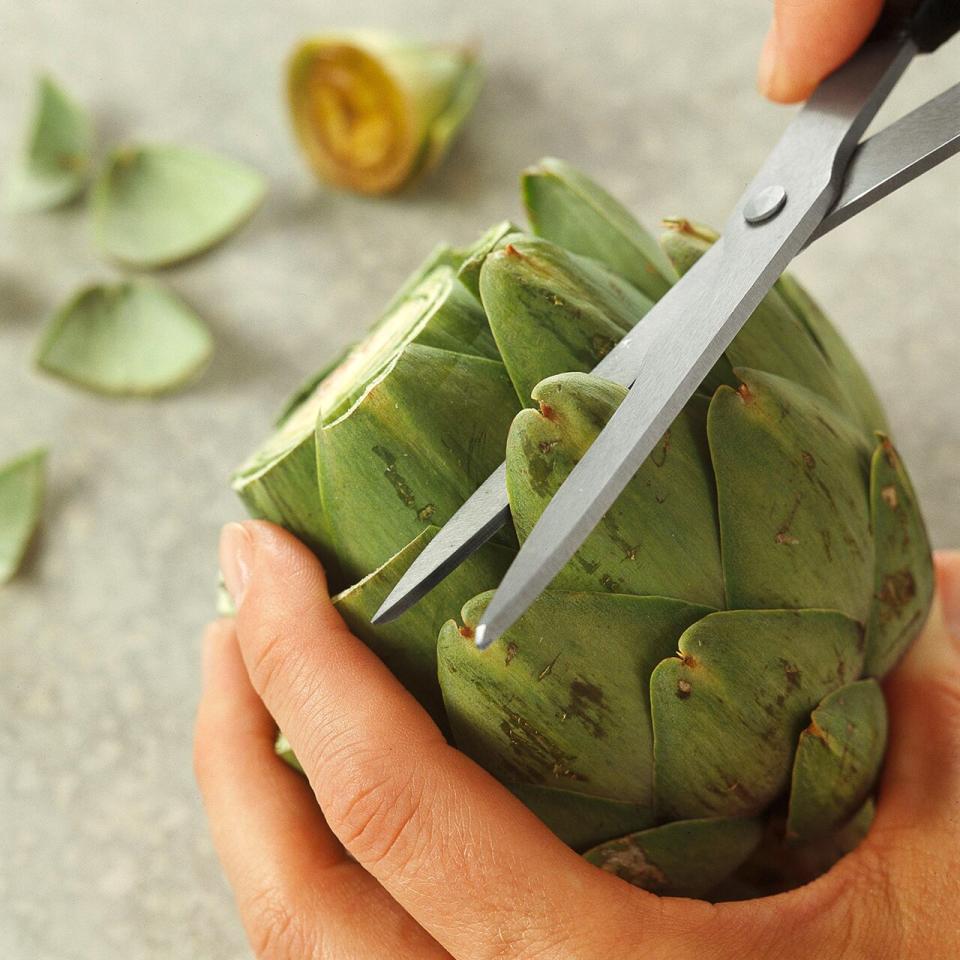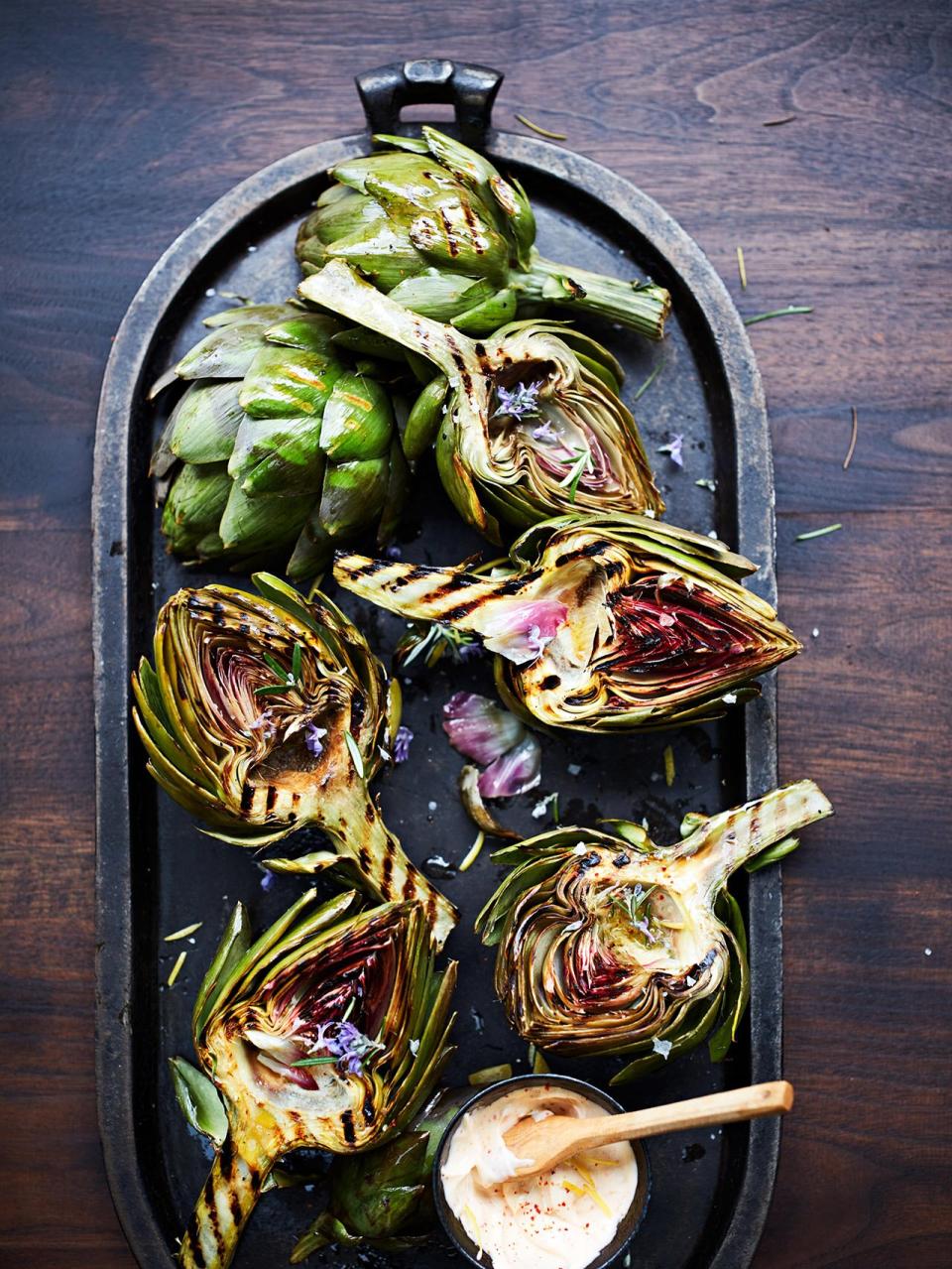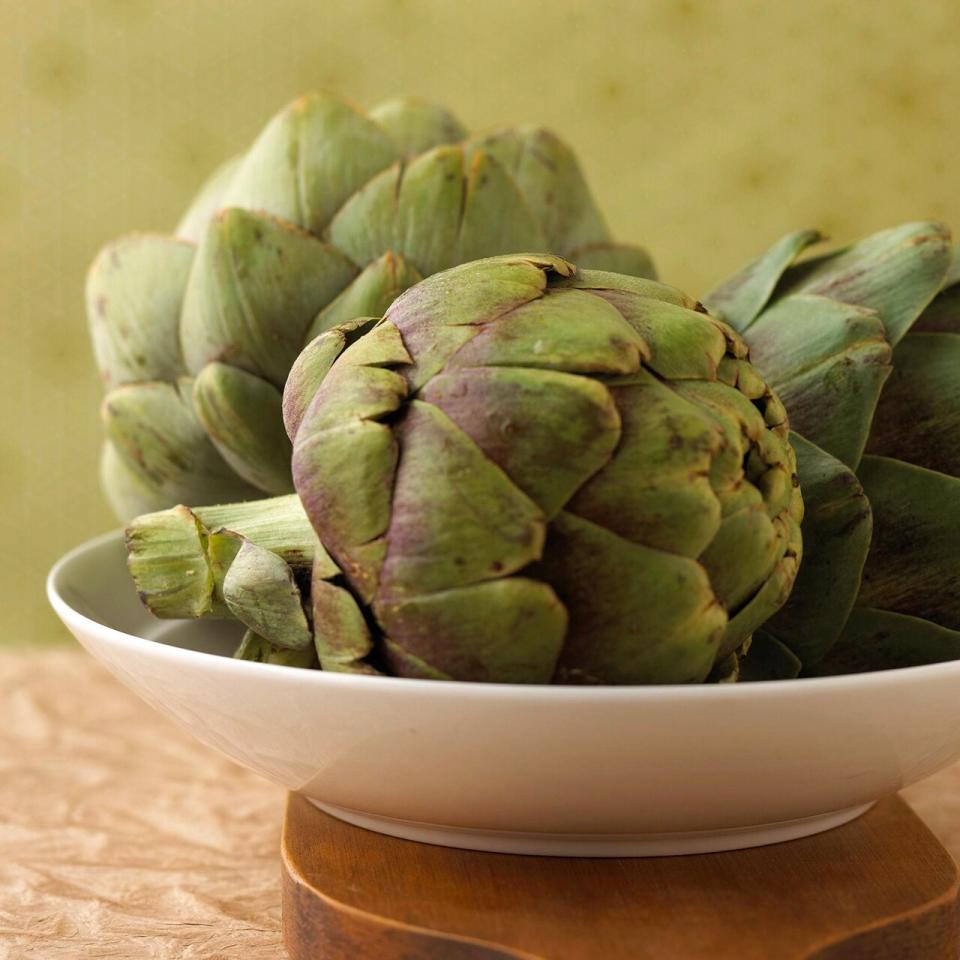How to Cook Artichokes for a Scene-Stealing Side Dish
Artichokes are the edible immature flowers of a cultivated thistle. There are more than 50 varieties of globe artichokes (the "true" artichoke not related to the Jerusalem artichoke, which is a tuber) grown around the world. Roasted artichokes, in particular, possess a distinctly sweet, nutty flavor and are popular in French, Spanish, and Italian cuisine. Clearly, since you're here, you’ve selected the veggie star of your recipe, so it’s time to learn how to cook artichokes. The ways to cook artichokes almost outnumber the delicious leaves on produce! For the unacquainted, we'll share how to eat artichokes and include some artichoke recipes, plus dish on the best way to serve stuffed artichokes and grill artichokes.
How to Cook Artichokes
From washing to eating, here's the step-by-step process.
Wash the Artichokes
Wash artichokes just before you’re ready to use them. If you wash artichokes before storing, the moisture could cause them to spoil more rapidly.
Slice Off the Stem End
Cut off and discard the end of the stem. Or remove the entire stem at the base if you plan to serve the artichokes standing upright for recipes like stuffed artichokes (try our slow cooker variation filled with sausage and sweet peppers!).

Robert Jacobs
Remove Outer Leaves
Peel off the outer leaves closest to the stem.
Remove the Top of the Artichoke
If you are making stuffed artichokes or simply want to remove the majority of the prickly leaf tips for safer eating, trim the top off each artichoke. Use a sharp, sturdy knife to cut off about 1 inch from the pointed top of each artichoke.

RJT LLC
Trim Leaf Tips
Remove the remaining prickly tips from the outer leaves by using scissors to cut off each leaf tip.
Test Kitchen Tip: Brush all cut edges with lemon juice to prevent browning.
Choose Your Cooking Method
Related: Try All of Our Favorite Artichoke Recipes
There’s no one best way to cook artichokes—there are many! Try them all or start with whichever method is closest to the artichoke recipe you’ve enjoyed most while dining out.
Test Kitchen Tip: How long to cook artichokes varies based on size. For all methods, you’ll know they're done when you can slip off a leaf near the center of the artichoke without struggling or having to pull too hard.
Boiling Artichokes
If you can bring a pot of water to a boil you already have the basics of how to boil artichokes down!
Fill a large stainless-steel or enamel pot with about three inches of lightly salted water; bring to boiling. Check out this Calphalon 8-quart multi-pot ($104.99, Bed Bath & Beyond), if you need the right size pot.
Add artichokes; return water to boiling.
Reduce heat; simmer, covered, about 20 to 40 minutes or until you can easily pull a leaf from the center of an artichoke. This is the key to know how long to boil artichokes. Test at the minimum boiling time, then again every couple minutes until a leaf easily slips out.
Test Kitchen Tip: Cooking artichokes by boiling doesn't impart flavor. If you're looking for the purest artichoke flavor, boiling is a good method. Or add butter, sauces, or other toppers to make boiled artichokes more flavorful.

Con Poulos
Grilling Artichokes
The first step in how to cook artichokes on the grill is to boil them first, so be sure you feel confident in that method of cooking artichokes.
Fill a large stainless-steel or enamel pot with lightly salted water; bring to boiling. Reduce heat; simmer, covered, about 20 to 30 minutes or until you can easily remove a leaf from the center of an artichoke.
Heat grill or grill pan to high. Cut artichokes in half lengthwise, then scoop out the choke and the delicate inner leaves close to the heart. Season to taste with salt and black pepper; drizzle with olive oil.
Place artichokes on the hot grill, flat sides up; cook until golden brown (about 4 minutes). Flip and cook 4 minutes more.
Steaming Artichokes
With the use of a pot and steamer basket like this OXO stainless steamer ($19.95, Williams Sonoma), you can steam artichokes like you would any vegetable.
Fill a large stainless-steel or enamel pot with 1 inch of water.
Place a steamer basket inside the pot.
Bring the water to boiling.
Using tongs, place artichokes, stem side down, in the steamer basket.
Reduce heat to simmering, cover the pot, and allow artichokes to steam 20 to 25 minutes or until you can easily pull a leaf from the center of artichoke.
Test Kitchen Tip: Be sure to use a stainless-steel, enamel, or other nonreactive pot to cook artichokes to prevent discoloration or off-flavors.
Roasting Artichokes
Roasted veggies are nearly irresistible (even to picky eaters), the same holds true for roasted artichokes.
Preheat oven to 425°F.
Gently separate the artichoke leaves from the choke to loosen.
Drizzle the whole artichoke(s) with lemon juice and olive oil; season to taste with salt and black pepper.
Tightly wrap in aluminum foil, place in an oven-safe baking dish, and roast 70 to 80 minutes.
Microwaving Artichokes
You can enjoy eating whole artichokes even when you're in a hurry.
Place two artichokes in a glass bowl, pie plate, or microwave-safe casserole dish with ½ cup water. (You could add ½ tsp. each lemon juice and oil, if you like.)
Cover with vented plastic wrap, or the lid of the casserole dish. Microwave, covered, on 100% power (high) 7 to 10 minutes.
Test for doneness by piercing the bottom of the artichoke with a toothpick. It should pierce easily (like when you fork-test a potato). If you feel a hard spot, cook another minute and re-test.
Let stand 5 minutes.
How to Eat Artichokes
Now that your artichoke recipe is ready, it’s time to peel and dig in.
To Eat a Whole Cooked Artichoke
If you thought cooking artichokes was intimidating, being served one for the first time can cause the same feeling. Here's how to proceed.
Break off each leaf, one at a time; dip the leaf into melted butter, mayonnaise, or other sauce (see some ideas below) and draw the base of the leaf through your teeth to remove the tender portion.
After all the leaves have been removed, scrape off the inedible prickly "choke" to expose the inner artichoke heart.
Cut the heart into pieces (and prepare to battle over the last bite).
To Use the Cooked Artichoke Heart in a Recipe
Your freshly-cooked artichoke heart can be added to recipes just like you would add jarred artichoke hearts.
Peel leaves from artichokes. Scrape off the inedible prickly "choke" to expose the heart.
Cut the heart in half or as directed in a recipe (psst...spinach-artichoke dip is always a hit!).
Related: Party-Ready Make-Ahead Dips
Optional Sauces to Serve with Your Artichoke Recipe
No matter your cooking method, artichoke leaves taste even better when dunked into one of these stir-and-serve sauces:
Herb-Butter Sauce: Melt ¼ cup butter. Stir in 1 tablespoon lemon juice and 1 teaspoon snipped fresh dill, tarragon, or oregano (or ¼ teaspoon dried dill weed, tarragon, or oregano, crushed). Makes 2 servings.
Lemon-Mustard Mayo: In a small bowl stir together ½ cup mayonnaise or salad dressing, ½ teaspoon finely shredded lemon peel, 2 teaspoons fresh lemon juice, and 1 teaspoon Dijon-style mustard. Season to taste with ground black pepper. Serve with warm or chilled artichokes. Makes 4 servings.
Curry Dip: In a small bowl stir together ½ cup mayonnaise or salad dressing, 1 teaspoon lemon juice, 1 teaspoon prepared horseradish, 1 teaspoon finely chopped onion, 1 teaspoon curry paste or curry powder, and ⅛ teaspoon salt. Cover and chill 2 to 24 hours before serving with chilled artichokes. Makes 4 servings.

Blaine Moats
How to Choose and Store Artichokes
Use these Test Kitchen tips to select the very best artichokes and store them properly:
The peak season for leafy green globe artichokes lasts from March to May.
Look for artichokes with tight leaf formation and a deep green color. They should seem heavy for their size, and the leaves should squeak when squeezed together. Avoid artichokes that are dry-looking or have split leaves. The color should be a vibrant green, and the outside should be unblemished. Generally, the smaller the artichoke, the more tender it will be. However, plump, round-looking artichokes tend to have a larger heart, which is the sweetest part of the artichoke.
Store unwashed artichokes in a plastic bag in the refrigerator up to 4 days.

